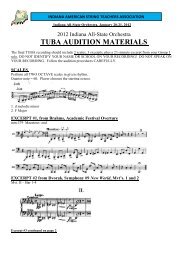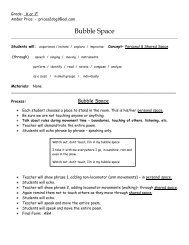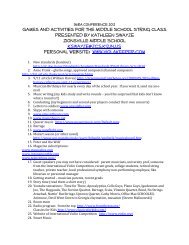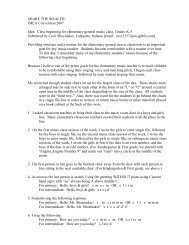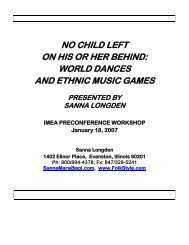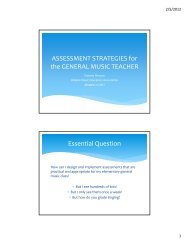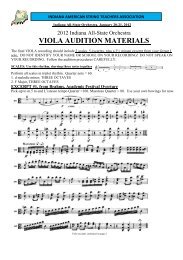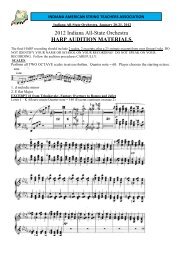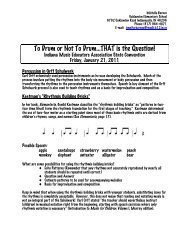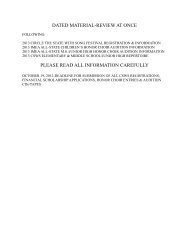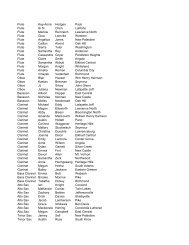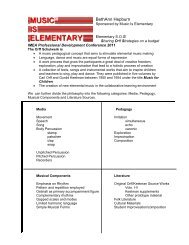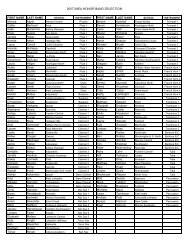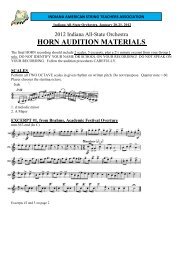Kids are Kids - Indiana Music Education Association
Kids are Kids - Indiana Music Education Association
Kids are Kids - Indiana Music Education Association
You also want an ePaper? Increase the reach of your titles
YUMPU automatically turns print PDFs into web optimized ePapers that Google loves.
Urban vs. Suburban:<br />
<strong>Kids</strong> <strong>are</strong> <strong>Kids</strong><br />
<strong>Indiana</strong> <strong>Music</strong> Educators <strong>Association</strong> Workshop<br />
Saturday, January 22, 2011<br />
Holly Mullenix-Stack<br />
<strong>Music</strong> Specialist<br />
National Teachers Academy<br />
Chicago, IL<br />
hollymullenix@gmail.com<br />
Laura Stack<br />
<strong>Music</strong> Specialist<br />
Highcrest Middle School<br />
Wilmette, IL<br />
laurastack1034@gmail.com<br />
IMEA 1/22/2011 Holly Mullenix-Stack & Laura Stack
Sansa Kroma<br />
Objective: Students will experience a folktale song from Ghana through singing in the Akan language,<br />
learning the translation and meaning of the piece, and perform the playground game in layered ostinato using<br />
body percussion and unpitched percussion instruments while working together as one team.<br />
Formative Assessment:<br />
• Layered four part ostinato while singing<br />
Summative Assessment:<br />
• Simultaneous performance of singing, beanbag game, and playing instruments<br />
Materials:<br />
• Adzenyah, Maraire, Tucker. Let Your Voice Be Heard: Songs from Ghana and Zimbabwe. 1997.<br />
World <strong>Music</strong> Press.<br />
Process:<br />
ü Teacher speaks entire song, Sansa Kroma, in rhythm.<br />
Song: Sansa kroma ne na wuo okyekyer nkoko mba<br />
Translation: Sansa, the hawk. You <strong>are</strong> an orphan, and so you snatch up baby chicks.<br />
ü Teacher sh<strong>are</strong>s translation and meaning/story behind song.<br />
ü Teacher speaks song again asking students to listen for any repeating phrases.<br />
ü Students discuss with an elbow partner then sh<strong>are</strong> answers with whole class.<br />
ü Students analyze how many times phrase was repeated. Which phrases were slightly different and how?<br />
ü Students learn song through echo imitation.<br />
ü Teacher sings song and asks students to analyze similarities/differences again with their elbow partner.<br />
ü Students learn melody through simultaneous imitation.<br />
ü While singing song all students move to circle on floor.<br />
ü Teacher demonstrates circle game (tap, tap, pass, clap) with beanbags.<br />
ü Beanbags distributed one at a time as passed around circle with rhythm.<br />
ü Once all students have a beanbag and <strong>are</strong> comfortable with the rhythm, add melody while rhythm with<br />
beanbag in motion.<br />
ü Students discuss challenges and successes.<br />
ü Once comfortable, teach clave rhythm to all students using words, Flying through the sky.<br />
ü Teacher sings song while all students simultaneously speak clave rhythm.<br />
ü Class divided into two sections. ½ sing melody:½ speak and clap clave rhythm<br />
ü Switch parts.<br />
ü Transfer clave rhythm to instrument and continue with game.<br />
IMEA 1/22/2011 Holly Mullenix-Stack & Laura Stack
Movement Exploration with Shapes<br />
Objective: Individually, in small groups and whole groups, students will experience, move, and analyze<br />
smooth and sharp movements through the interpretation of shapes.<br />
Formative Assessment:<br />
• Visual interpretation of geometric shapes through body shapes<br />
• Movement of body demonstrating smooth and sharp<br />
Summative Assessment:<br />
• Improvisational movement in small groups through shadowing to demonstrate application of smooth and<br />
sharp movements.<br />
Materials:<br />
• CD: Dreamcatcher by Secret Garden “Adagio”<br />
• CD: Rhythmically Moving 6 “Iste Hendek”<br />
• CD: Pieces of Africa by Kronos Quartet “Maraire: Mai Nozipo (Mother Nozipo)”<br />
Process:<br />
ü Teacher directs students to work together as a community to form the shapes they seen on the screen.<br />
ü Students form a group circle<br />
o Teacher prompts students to use smooth movements:<br />
§ Melt into the center<br />
§ Float to the outside<br />
§ Sway in the wind<br />
ü Students form a group squ<strong>are</strong><br />
o Teacher prompts students to use sharp movements:<br />
§ Travel like a robot<br />
ü Students form a group triangle<br />
o<br />
Teacher leads shadowing demonstration while students<br />
simultaneously imitate smooth and sharp movements<br />
ü Students scatter position and form individual circles<br />
o Teacher prompts students to use smooth movements<br />
ü Students form individual squ<strong>are</strong>s<br />
o Teacher prompts students to use sharp movements<br />
ü Students form triangles in small groups<br />
o Student leaders leads shadowing using smooth and sharp movements<br />
ü Teacher leads discussion in categorizing specific movements as smooth or sharp. SMARTBoard Vortex<br />
Category is used as a visual aide.<br />
o SMOOTH: *Glide, *Float, *Wring, *Press, Melt, Sway<br />
o SHARP: *Flick, *Dab, *Punch, *Slash, Kick, Burst<br />
§ *Indicates one of the basic movement efforts categorized by Rudolph Laban<br />
IMEA 1/22/2011 Holly Mullenix-Stack & Laura Stack
Shapes Unit<br />
Objective: In small groups and whole groups, students will experience, speak, play, move, compose, and<br />
analyze compound meter through the use and manipulation of shapes.<br />
Formative Assessment:<br />
• Manipulation of shapes through speech<br />
• Hand drum performance-based<br />
• Form analyzation of phrases (AABCBCA)<br />
• Movement of body demonstrating smooth and sharp<br />
Summative Assessment:<br />
• Performance of seven measure B section composition including at least two of the following: body<br />
percussion, creative movement, unpitched/pitched percussion<br />
Materials:<br />
• Gunild Keetman. Rhythmische Ubung (Rhythm Exercises). Schott Publishers.<br />
Process:<br />
ü Please shape manipulative measures <strong>are</strong> on board in random order.<br />
ü Teacher taps shapes while students speak in rhythm.<br />
ü Students come up to board and put the shapes in a different order.<br />
ü Teacher places in order according to piece, Rhythmische Ubung #43.<br />
ü Students speak while teacher taps downbeat in order from beginning to end.<br />
ü Students, as a class, analyze the form of the piece: AABCBCA.<br />
ü Once comfortable, students perform without teacher.<br />
ü Transfer rhythm of shapes to hand drums.<br />
Play down stroke on the downbeat of each triangle and squ<strong>are</strong>.<br />
ü Once comfortable, add up stroke on hand drum of rhythm of triangle.<br />
Triangle Squ<strong>are</strong> (down up up – down)<br />
Triangle Squ<strong>are</strong> (down up up – down)<br />
Circle, Circle, Circle<br />
Triangle Triangle (down up up – down up up)<br />
Circle, Circle, Circle<br />
Triangle Triangle (down up up – down up up)<br />
Triangle Squ<strong>are</strong> (down up up – down)<br />
IMEA 1/22/2011 Holly Mullenix-Stack & Laura Stack
Once comfortable, add a down stroke on the downbeat of circle.<br />
ü Finally, add up stroke on the rhythm of circle<br />
Triangle Squ<strong>are</strong> (down up up – down)<br />
Triangle Squ<strong>are</strong> (down up up – down)<br />
Circle, Circle, Circle (down up – down up – down up)<br />
Triangle Triangle (down up up – down up up)<br />
Circle, Circle, Circle (down up – down up – down up)<br />
Triangle Triangle (down up up – down up up)<br />
Triangle Squ<strong>are</strong> (down up up – down)<br />
COMPOSITION<br />
ü Review and act out Small Group Success Guidelines.<br />
o Level 2 (noise level within a small group).<br />
o Stay with group.<br />
o Raise your hand for help.<br />
o Stay on task as a team.<br />
o 2 echo rhythms to return to Level 0 (no noise) and eyes on teacher.<br />
ü Students <strong>are</strong> divided into groups of 6-8.<br />
ü Students compose seven measures using shape manipulative envelopes.<br />
o Create composition, which will later be the B section.<br />
o Practice playing composition as a group.<br />
§ Practice rhythm first.<br />
§ Edit, if needed. All must be able to perform.<br />
§ THEN, add movement, body percussion, percussion).<br />
o Raise hand when ready to perform B section in small group for teacher.<br />
o T gives feedback to students.<br />
ü Final Rondo performance with student input on form.<br />
IMEA 1/22/2011 Holly Mullenix-Stack & Laura Stack
Hlnolofatsa<br />
Objective: Students will experience a song from South African through singing in the Sesotho language,<br />
learning the translation and meaning of the piece, and perform the piece in harmony with dance and unpitched<br />
percussion.<br />
Formative Assessment:<br />
• Sing and dance South African song in harmony to foster community and celebration<br />
Process:<br />
ü Teacher sings middle line twice with rests in between each repeat<br />
ü Teacher asks students to listen for the missing syllable<br />
o Students identify the missing syllable at the end of phrase four before the repeat “te”<br />
ü Teacher gives background on South African piece<br />
o Song:<br />
o Meaning: We <strong>are</strong> blessed. We <strong>are</strong> blessed in the name of the Lord<br />
o Often the higher parts never get to finish their phrase<br />
o Village/Community building<br />
o Focus is on the singing on the movement – movement used to free the body<br />
ü Teach speaks “Hlnolofatsa” in rhythm for pronunciation<br />
ü Teacher sings the beginning of each phrase - Students speak “Hlnolofatsa” in rhythm every time teacher<br />
points to them<br />
ü Teacher asks students how many times they said “Hlnolofatsa” (3)<br />
ü Students echo teacher singing phrase 1, phrase 1 & 2, phrase 3, phrase 1 2 & 3<br />
ü Students sing phrase 1, 2, 3 and teacher sings phrase 4 - add quick repeat<br />
ü Teach speaks “Ka Lebisto la ntate” in rhythm for pronunciation – Students repeat<br />
ü Students echo teacher singing phrase 4 “Ka Lebisto la ntate” - add “yo, ka Lebisto la ntate”<br />
ü Students sing entire piece<br />
ü Teacher demonstrates typical South African dance (in & out)<br />
ü Students stand in circle and join in with South African dance<br />
ü Students sing and dance middle line<br />
ü Teacher adds top line harmony<br />
ü Teacher invites a group of singers to listen and jump in on the top part<br />
ü Some students add drumming and unpitched percussion<br />
ü Students sing, dance “Hlnolofatsa” in harmony with unpitched percussion<br />
IMEA 1/22/2011 Holly Mullenix-Stack & Laura Stack



